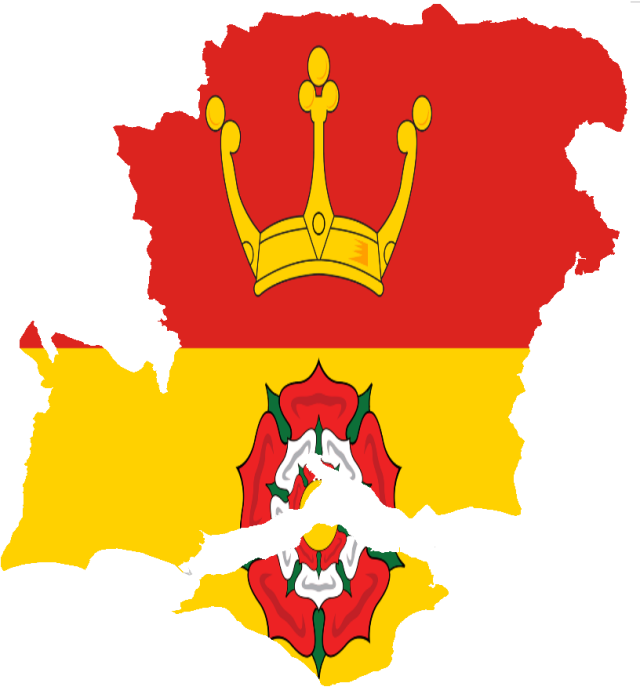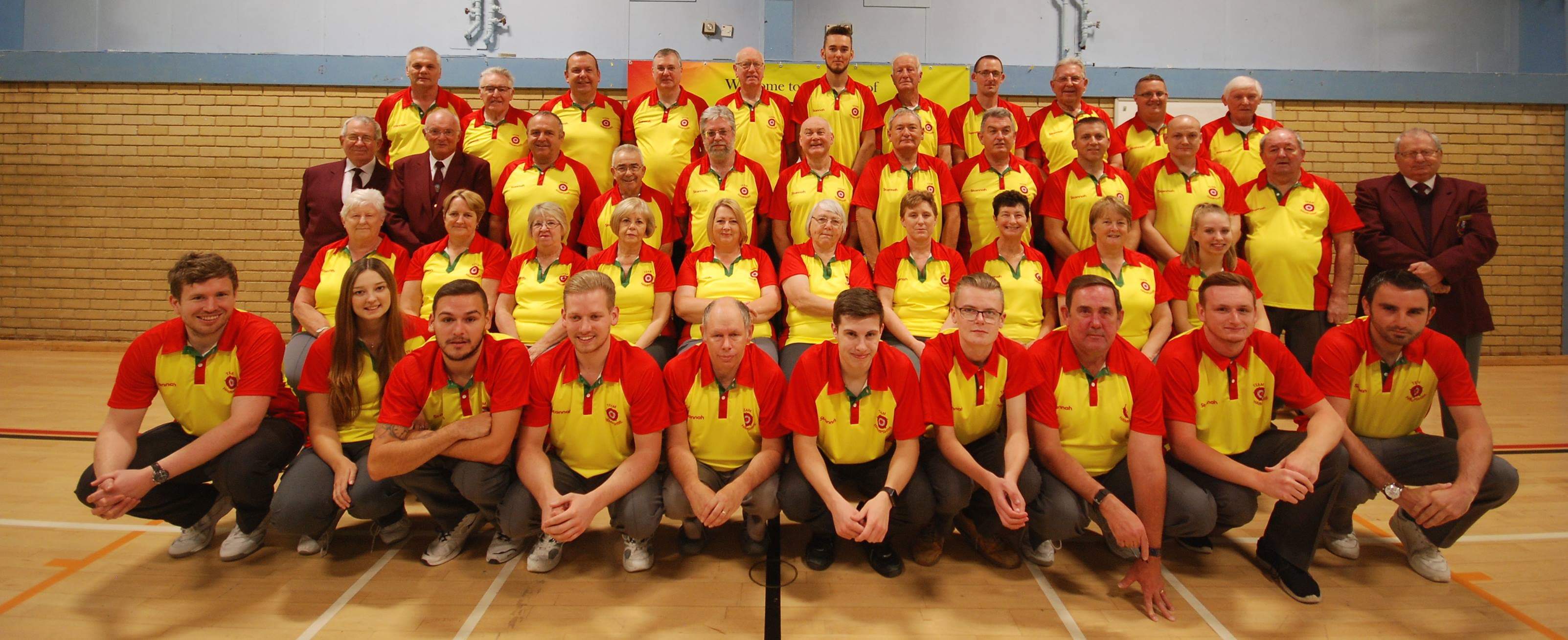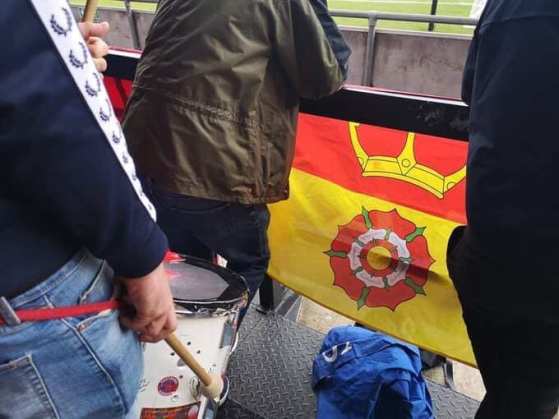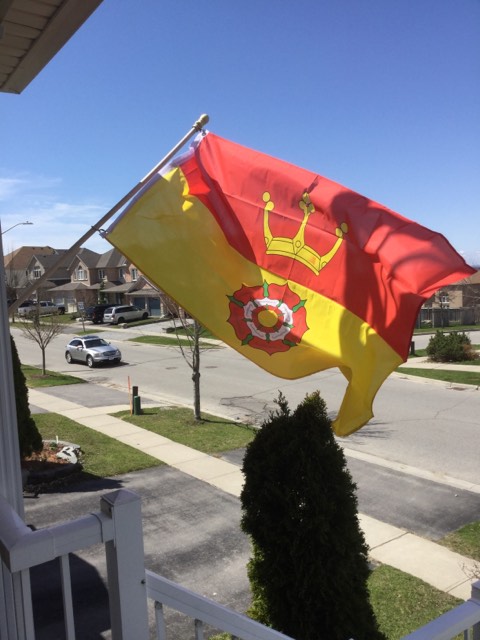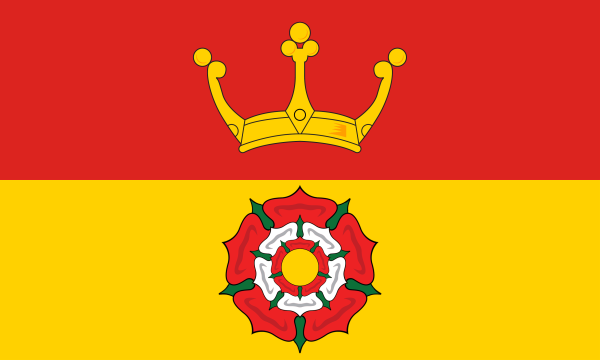
The flag of Hampshire, conceived by Jason Saber and further refined by Brady Ells, retains the rose and crown pattern used in the county for several centuries. and was registered on March 12th 2019. One account holds that the rose was granted to a contingent of Hampshire archers and soldiers by King Henry V, at the battle of Agincourt, for bravery. There was no such “Hampshire” group however, as fighting men were retained by a noble and deployed by him in obligation to the crown, not drawn en masse, from any county. A sketchy alternative idea is that it was awarded to the county by John of Gaunt, in some circumstance. Another plausible theory for the the association of the rose with Hampshire, lies with Edmund (“Crouchback”, 1245-1296), Earl of Lancaster, son of Henry III (1216-1272) and brother of King Edward I (1272-1307), who held estates in the county. A gold rose
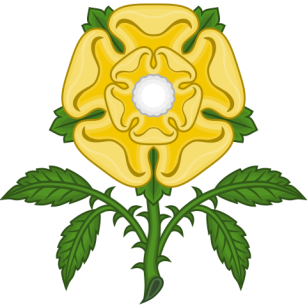
was an often used royal badge under King Henry III, who was born in Winchester Castle and often known as Henry of Winchester and his successor Edward I. Henry III adopted his golden rose from his wife, Eleanor of Provence and this royal badge was then used by the four subsequent monarchs but Henry’s son Edmund, the first Duke of Lancaster, is believed to have distinguished his own badge by changing his father’s golden rose to a red one. In 1283 he brought Somborne Hundred in Hampshire, into the Earldom of Lancaster, establishing a connection between his red rose and the county.
Edmund’s red rose subsequently passed down through descent and marriage, to Henry of Bolingbroke, who took the crown as Henry IV (1399 – 1413) and converted the Duchy of Lancaster into an appendage of the Crown, as the personal fief of the reigning monarch, in 1399. The theory holds that this act, symbolised by the adding of a crown to the rose emblem, is the origin of the distinct Hampshire rose and crown combination. Hampshire history website advises that a combined rose and crown appeared on the fourteenth century staple seal (Statute of the Staple) in Southampton.
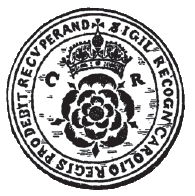
Notably, the combined device of rose and crown also featured as a decorative element on the cannon

of the Henry VIII warship, the “Mary Rose”, constructed in Portsmouth and as Hampshire history further relates, a combined Rose and Crown was also the seal of the Custos Rotulorum (Keeper Of The Records) for Hampshire, in the period 1625–1649, the reign of Charles I. Perhaps the use of ostensibly royal insignia in such contexts inspired the local take up of the combination?
A rose is also present in the Great Hall in Winchester

where a round mediaeval table
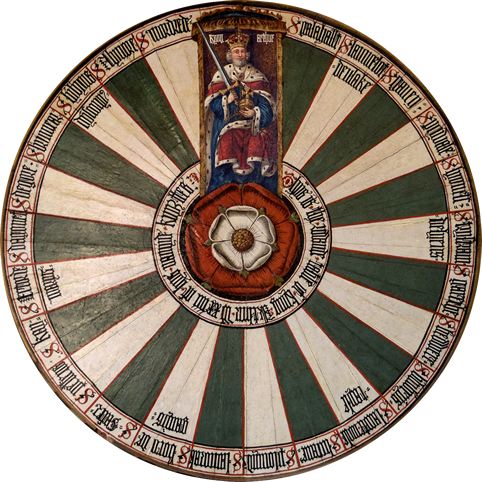
with a double Tudor rose of inner white petals and outer red ones, at its centre, is positioned on a wall
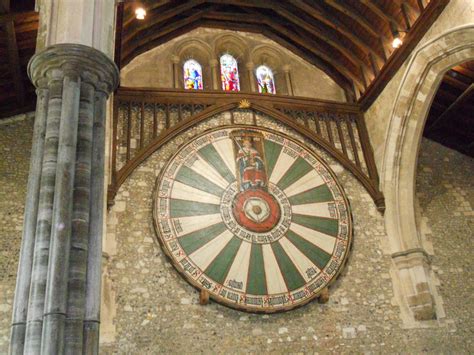
The table is a presentation of the famous round table of Arthurian legend, where all the knights of the court sat and is believed to date from around the fourteenth century. There is no firm evidence but it is supposed that originally, under King Henry III, the rose would have been typically gold. The symbolism of the legendary round table and the Arthurian age was powerful, perhaps the association between Hampshire and its floral emblem arose from its presence on this revered artefact? People in that era may well have believed that this actually was King Arthur’s round table, allowing for the development of a mystique around the emblem of the rose at its centre and firmly embedding it in popular culture. In the reign of Henry VIII (1509-1547), with the establishment of the bi-colour Tudor rose, the table was repainted to depict the Tudor version, commonly seen in Hampshire emblems.
The evident local antiquity of the rose per se, is recalled in the widespread use of the name “Hampshire Rose” throughout the county. The “Hampshire Rose” is widely used in the arms of Hampshire people and places, appearing on the civic arms of Southampton,
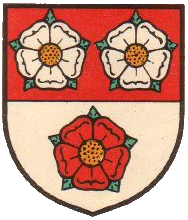
which, incidentally, appear on a heraldic roll from the time of Edward IV, 1461 – 1483, denoted as the arms of ‘Hampton’;

Southwick Priory, Fareham, which has two white roses on a black chief

Fareham itself;
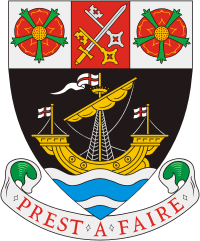
Rushmoor.

Petersfield

and although in a somewhat unorthodox shade of blue (!) a specifically described ‘Hampshire rose’ is also present on the civic arms of Bournemouth,

in the grasp of a lion

(also blue!) to emphasise its status as a Hampshire town.
Additionally, the rose bearing arms of “Winchester College”

and ”New College”

, Oxford, derive from the arms of William of Wykeham, a celebrated Hampshire bishop.
The oldest reference of a crown and rose in combination, as a specific Hampshire emblem, appears to date from 1681, with its inclusion as a decorative element on the ceremonial mace used by the Borough of Stockbridge, as recounted by the Hampshire Field Club in the early twentieth century

and later in the Stockbridge Parish magazine

The Rose and Crown referred to is seen on these images of the mace
kindly provided by Geoff Merritt of Stockbridge and District Local History.
The 1686 mace used in the Borough of Petersfield

also features a crowned rose

In the following centuries, the combination was included on locally issued currency
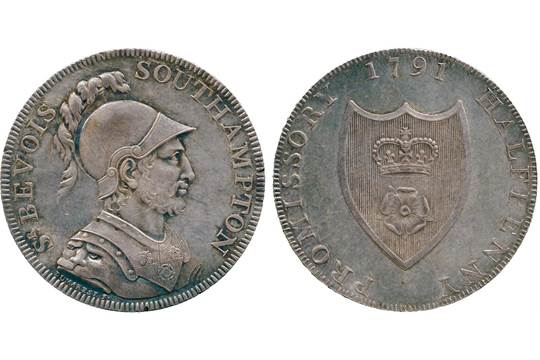
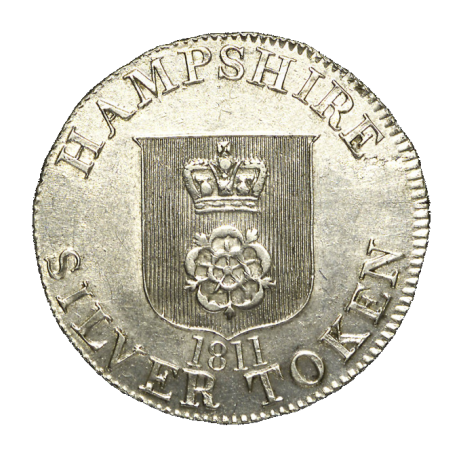 and in 1842 a device comprising the rose surmounted by a crown, with a cap, surrounded by a wreath of laurel leaves,
and in 1842 a device comprising the rose surmounted by a crown, with a cap, surrounded by a wreath of laurel leaves,
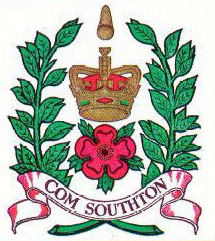
appeared on official documents. In 1889 Hampshire County Council (HCC) was established and in 1895 it adopted this recognised county badge of combined rose and crown symbol as a heraldic badge (similar to a company logo)
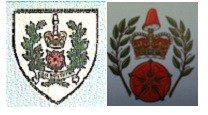
although without legal sanction. The badge is seen here

on a county fire service vehicle

Another notable county organisation to adopt the crown and rose motif, as a seal, was the aforementioned Hampshire Field Club And Archaeological Society, in 1906,
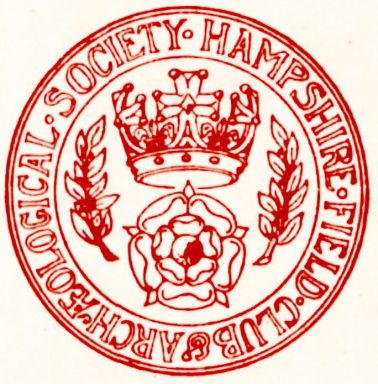
The take up of this device was described at some length in the organisation’s magazine which reads “The rose and crown, with sprays of laurel,
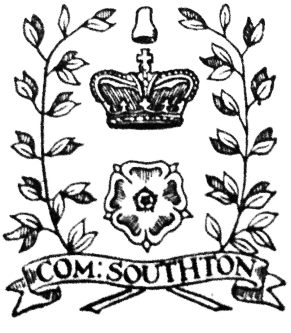
appear in some old books and records belonging to the county, deposited at Winchester and these have furnished authority for the badge of the County Council who have adopted this form…”. The description further states “The rose and crown is freely used throughout The Great Hall of Winchester Castle as an architectural ornament…”




Pointedly the journal also states “…the rose and crown has been accepted for a considerable period as the County Badge…”
With regard to the precise form of rose featured in the seal adopted by the society, the publication also gives some consideration to the “variety” of roses deployed in Hampshire. “In the Cathedral of Winchester…” it reads, “…we have a variety of forms. In the roof of the choir…we have the double rose
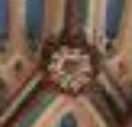

, also the single rose,
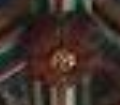
whether of York or Lancaster cannot always be determined. The roof of the nave…is also decorated with double roses
on the intersections of the vaulting ribs.”. The magazine continues, “The double rose assigned to the Tudors is found in a much earlier period, and the examples above referred to show that the combination dates back more than four hundred years” The society’s magazine then states that the specific inspiration for their choice of a double rose on its insignia, was a seal

used in Winchester, to seal bonds, under the Statute of the Staple, the city being a “staple” site for wool. This device appears to have become obsolete in the eighteenth century. Referring to the “Statute of Staple” seal, the magazine states that the society thus “…adopted the double rose which was certainly found in Winchester and elsewhere before Tudor times, and has been handed down to a more recent period. The full account of the society’s emblem and its derivation can be read here.
The combined rose and crown emblem subsequently featured on the cover and spine of the 1926 work ‘Unknown Hampshire’

, demonstrating the recognition of the combination as the definitive Hampshire emblem.
Hampshire County Council received a formal grant of arms in 1992

from the College of Arms, featuring a golden crown and a double rose with inner white detail, reflective of the rose on the table in the Great Hall in Winchester and other early depictions. The gold crown and red rose were placed against contrasting respective red and gold fields to enhance their visibility. Subsequent to the 1992 award, a number of business and other organisations in the county asked to use these arms but of course were declined for potential breach of copyright. Naturally, they were entitled to use their own versions of the insignia, resulting in a variety of depictions that included single red roses, double red roses and Tudor roses, thus continuing the “tradition” of varying forms of rose present in the county. Bearing out this point, a basic red “Lancastrian” rose is present on the badge of the county’s branch of the Air Training Corps

and on the insignia of this local brewery, with a brew significantly named “Hampshire Rose”

“Hampshire Rose” is also the official designation of the device that features on the badge
of the Royal Navy’s, 2nd Mine Countermeasures Squadron, based in Portsmouth, while a Tudor rose is found, for example, on the civic arms of Rushmoor, the Bournemouth rose, as noted, is blue and the rose used by the county cricket team is all white!
This appears to be a legacy of the “variation” which the above archaeological magazine refers to, whilst the device adopted from 1842 as the county badge, included a red rose, white depictions, set against a red shield of distinctive shape, also exist

This is also the likely source for the original white rose, regimental badge of the Hampshire Yeomanry

which subsequently opted for a reversed Tudor rose, with red inner and white outer petals

also used by the Hampshire constabulary
Interestingly Southampton Football Club includes a white rose, on the club badge.
reversing the pattern found on the lower half of the shield, in the the civic arms borne by the city council, as seen above. This perhaps reflects the county’s use of a variety of different roses through the years and the specific use of a white one by various bodies, as demonstrated
The badge of the modern 457 (Hampshire Carabiniers Yeomanry) Battery of the Royal Artillery, created in the 21st century recalls that used by the original yeomanry for which it is named but has now opted for a more traditional form of Tudor rose
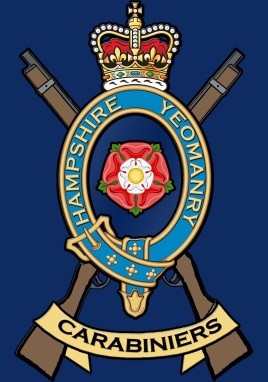
which is the version, slightly amended for distinction, found on the Hampshire flag, inspired by the double rose on the “Arthurian” table in Winchester hall

; the description in the Hampshire Field Club And Archaeological Society journal that such a design had been used in the county even before Tudor times; that body’s own adoption of a double rose for its insignia; and the example of the “Statute of the Staple” seal.
Notably, the bottom sepal of the rose on the Hampshire flag points down, to represent “SOUTHamptonshire” in contrast to the rose on the flag of Northamptonshire

which points up, to signify NORTHamptonshire. This is the orientation of rose which appeared on the aforementioned “Staple Seal” and is also found, for example, on the badge of the Hampshire Volleyball Association

; North Hants Golf Club (inner, white rose)

; Hampshire Ruby Union

; Hampshire Womens Institute
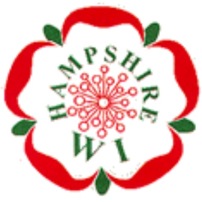
; and of course the rose on the arms of Hampshire Council itself, as seen.

Hampshire Scouts

and Hampshire County Pool Association
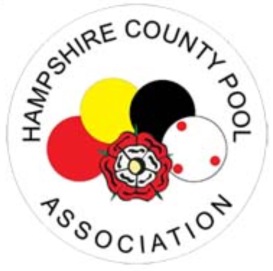
both also display a Tudor rose but without the distinct downwards sepal.
Yet another variation of rose design has been deployed by the Hampshire Regiment

namely, a very distinctive red and gold design
as appears on this World War Two cloth badge

This highly distinctive red and gold design is also seen here

alongside red and yellow pennants, deployed by the modern military unit, 295 (Hampshire Yeomanry) Battery of the Royal Artillery; also named for the original county Yeomanry unit and with a badge that again reflects that of its its predecessor but in the modern military style and colours. The uniquely coloured red and gold Hampshire military rose, maintains the county’s association with these colours, evident in the uniforms of the 18th century 37th (North Hampshire) Regiment of Foot, 1702-1881 and the 67th, (South Hampshire) Regiment of Foot, 1756-1881

which were merged on July 1st 1881, to form the Hampshire Regiment

which again bore a red and gold uniform. This unit was renamed the Royal Hampshire Regiment in 1946. The gold and red Hampshire Regimental drums are seen below

at the Royal Hampshire Regiment Museum.
Could these county colours and uniquely coloured, red and gold Hampshire military rose, have arisen from the belief that the rose on the table in Winchester Great Hall was originally gold? The same colour scheme is also found on the stylised rose device on the badge

of the Hampshire Small Bore and Pistol Association and the uniforms of the county’s Short Mat Bowls Association.
Perhaps this uniquely coloured, red and gold Hampshire military rose, was contributory to the choice of colours appearing in the coat of arms officially awarded to the county council in 1992? These

have been commercially available, in cloth form, in various realisations,
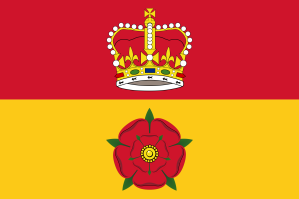

described as the Hampshire flag or county flag of Hampshire. However, such usage is in fact unlawful as the arms, in whatever form, represent just the council, which is in fact the only body permitted to use them, as explicitly stated by the College of Arms which advises “The regulations are not intended to permit the flying of armorial flags or flags bearing coats of arms; ….It is unlawful to fly or use a flag of the arms of any local authority save on sites or premises occupied by that authority.” The council itself has also stated this clearly on its own website
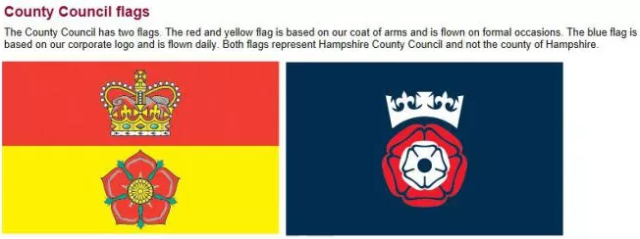
and has included the following question and answer exchanges regarding use of its armorial banner;
“Q: Can individuals or organisations fly the County Council flag?
A: Unfortunately, we cannot allow others to fly our flag because it represents Hampshire County Council and not the county of Hampshire.”
“Q: Can individual elements of the County Council’s coat of arms be used to make up the design of other organisation’s logos and flags?
A: Organisations can only include elements of our coat of arms in their logos and flags if they have been sufficiently redesigned so as not to infringe copyright. For example, the Hampshire rose is used by several organisations in Hampshire, but all look different.”
Additionally, the gold “Royal Crown”, on a red field, featured on the council’s arms

is itself, a highly restricted heraldic charge, which appears by special warrant, obtained for the council’s arms with a specific remit for this deployment. Such a warrant does not extend to its hoisting by the public, the Royal Crown may only be used with permission, as highlighted in this incident.
Thus, being doubly unavailable for the public to use, the council’s banner was not available for registration by the Flag Institute, as the flags it records must be freely available to the general public to fly. Notwithstanding such legal restrictions, the council arms, in various depictions, have been widely flown by Hampshire residents
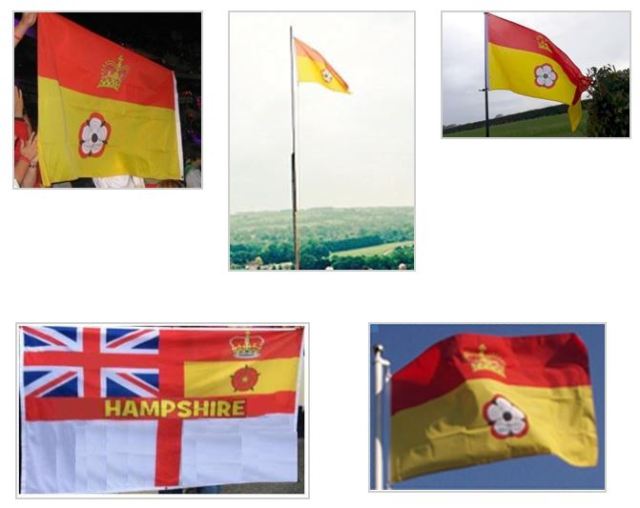


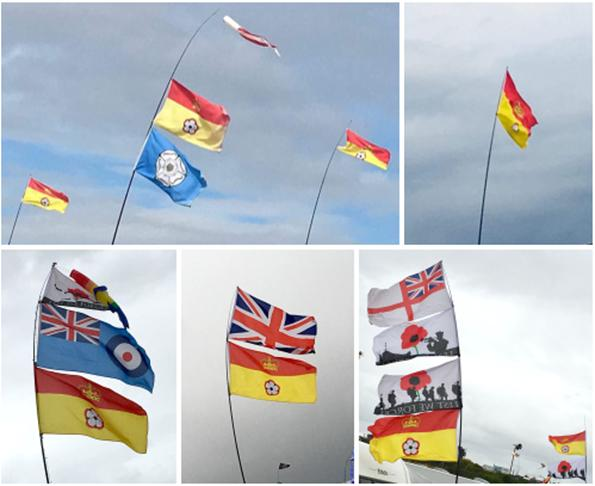
reflecting the countywide acknowledgment of the theme of rose and crown, as part of Hampshire’s history and tradition and this basic arrangement, against the bicoloured red and yellow background, was the outstandingly obvious choice for depiction on the county flag of Hampshire. A solution was found by substituting the much limited ‘Royal Crown’ with an alternative form, a Saxon Crown
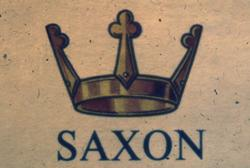
a charge which has no such restriction and is itself already used by the council on its own arms as part of the crest,
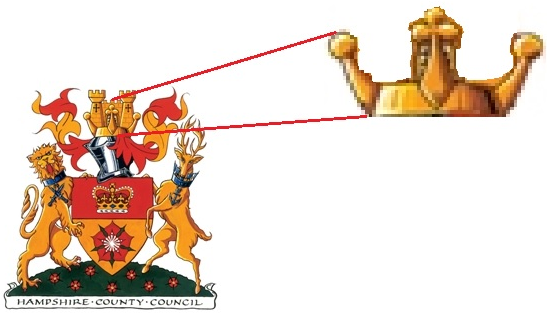
where it appears as a reference to the county’s association with the era of Alfred the Great and his capital of Winchester. The Saxon crown on the flag similarly recalls the county’s Alfredian legacy. The precise form of this heraldic charge was first deployed on the arms awarded to Middlesex County Council in 1910 on the advice of an author on military badges, Colonel Otley Parry, who identified the “Saxon Crown”, appearing on a silver penny,
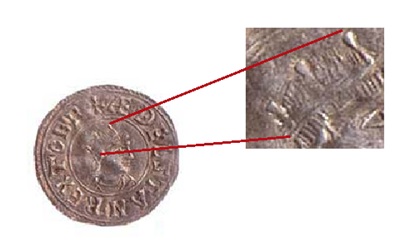
from the time of the Wessex king, Athelstan, 924-939. The earliest form of crown associated with the English monarchy, “Saxon” crowns had been used previously, for example on the arms ascribed to the kingdom of East Anglia but the 1910 depiction was based on a contemporary image rather than generic heraldic artistry as seems to be the case with the latter example. It is interesting to note that a precedent for representing the county with such a device was the 1963 badge of H.M.S. Hampshire
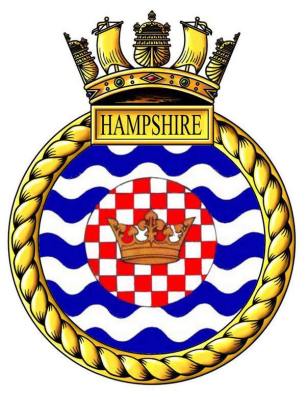
By 2018 Hampshire was one of only three English counties in England without a registered flag, prompting a campaign to see the county’s traditional rose and crown emblem, with the necessarily tweaked, Saxon crown,
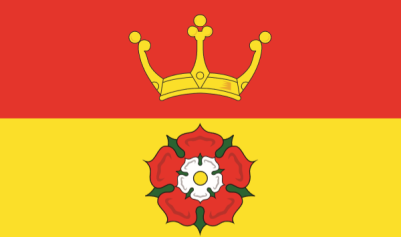
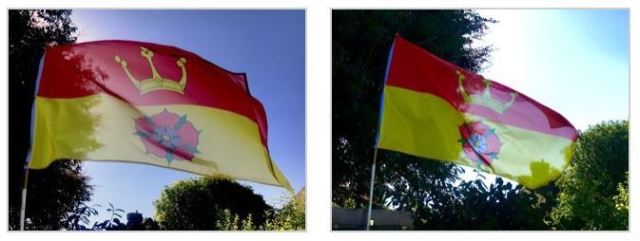
take its rightful place on the national record.
The effort to secure registration attracted the support of sixteen county organisations;
Lymington and District Historical Society,
Board of The Portsmouth Royal Dockyard Historical Trust
Hampshire Football Association
Hook Heritage Society
Bitterne Local History Society
Hampshire County Short Mat Bowls Association
Hampshire County Hockey Association
The City Of Southampton Society
The Portsmouth WEA Local History Group
Hampshire County Darts Organisation
Wessex Football Association
with one of their number, Lymington and District Historical Society, submitting a formal request for the flag’s registration, to the Flag Institute, on the basis of this countywide support base. In declaring its support, the county Hockey Association made a poignant case for the flag’s registration
“Please note that the Hampshire Hockey Association (which has itself for more than a century used the colours and rose proposed) strongly supports the proposed official flag for Hampshire. We frequently play against neighbouring counties who all seem to have an official flag. So must we.”
At this time the flag also appeared in the Daily Telegraph newspaper
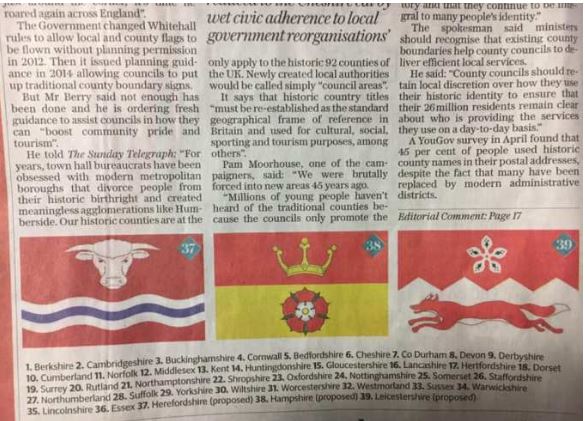
where it was used to highlight Hampshire’s status as one of only three counties without a flag, being presented as the proposed design.
Upon receipt of the request, the Flag Institute further required the sanction of a county official and declared support for the flag was subsequently received from both Hampshire County Council and the Hampshire Lord Lieutenant, Nigel Atkinson Esquire

and the flag was duly registered. Upon registration the flag was slightly reworked to its present form, with a distinctive rose device that mirrors that found on the above illustrated military depictions. The tripple rose, red, white, red, further reflects the variety of roses used to represent the county, its unique design distinguishing it from the roses used on other county flags.
The Hampshire flag has evolved over a decade, with various depictions that have refined the themes and concepts it embraces. An initial attempt, created in 2008,
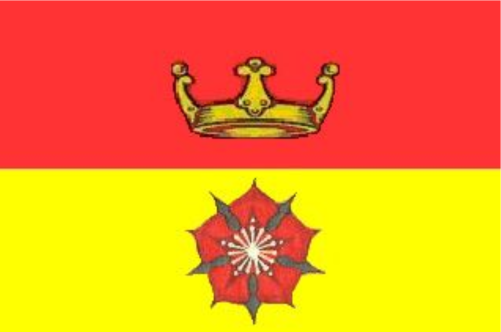
was a rough illustration using existing elements from other flags and arms, just to present the idea and “see how it looked” ! Unexpectedly, a flying version of this original form of the flag, with a slightly differently oriented rose, was spotted at the Square Tower in Old Portsmouth

A more sophisticated depiction followed

swiftly updated with a version provided by the Flag Institute
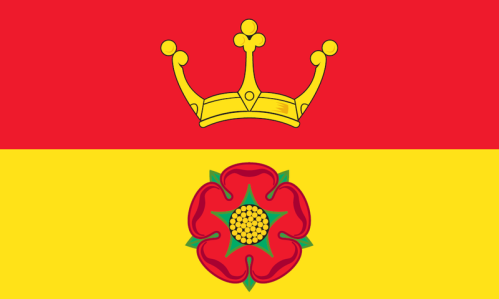
presented below

and seen here at Walbury Hill
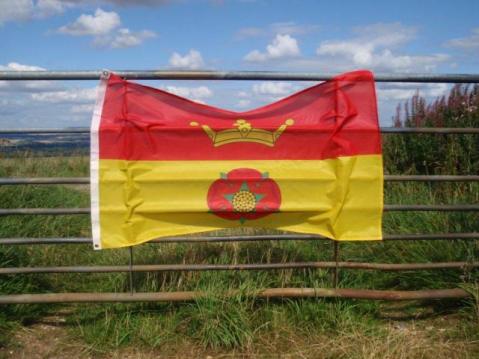
Up to this time the focus was mainly on the form of the crown, as detailed above and the image of the rose had not been considered but further research made it obvious that a Tudor style rose was a more appropriate reflection of the county’s symbolic history, as previously recounted. This resulted in the version of the flag that was promulgated before registration

seen here as a manufactured item

flying, below, by HMS Victory in Portsmouth.

and deployed here

on the side of a Landrover vehicle taking part in a rally. The contestants’ names are alongside the flags of their counties, Hampshire is at the top!
Upon registration, the Flag Institute effected a final change to produce a flag with a rose

that continued to reflect the county’s usage of various roses through the centuries but was also a distinct style for Hampshire, as described.
The newly registered Hampshire flag was first flown in the county alongside the flag of Dorset at their mutual boundary just west of Bournemouth.

The actual boundary has been picked out on the tarmac path seen here

and a boundary stone is in the foreground which is marked ‘BS’ on the below map extract of the area

The flag was first raised in an official capacity on the inaugural Hampshire Day, July 15th 2019, the date being the feast day of local saint Swithun (Swithin), often considered to be the county’s patron saint. A special logo

derived from the county flag, was produced for the occasion. At a ceremony held at the Castle Yard, at Winchester Great Hall, attended by an audience of around 100 guests,

Lord Lieutenant of Hampshire, Nigel Atkinson,

described how the County of Hampshire is older than England

itself and summed up his hopes for the day:
“Hampshire day is about celebrating everything that makes Hampshire great, its heritage, its world-famous historic sites, its diverse mix of towns and villages, the beautiful natural landscapes and above all the people of Hampshire both past and present. This is why I hope communities across the county will embrace Hampshire day in years to come by holding their own activities and celebrations so that over time this day will go from strength to strength in fostering a shared pride in Hampshire and all that it represents.”
Councillor Judith Grajewski commented “I think to have a day a year where we remember in our history and celebrate everything that’s good about Hampshire as it’s a diverse county, I think that’s a really good idea”
The event included an ensemble of student musicians from the Hampshire Music Service
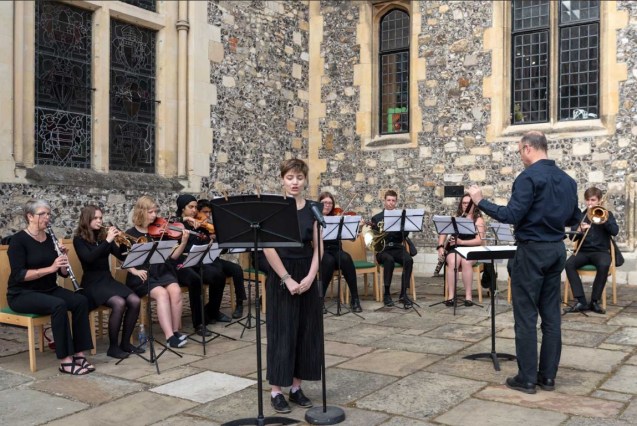
and was marked with a series of speeches, poems and songs

emphasising the uniqueness of the county of Hampshire.
Also attending were Chair of Hampshire County Council, Councillor Charles Choudhary and Catherine Ogle, the Dean of Winchester Cathedral,
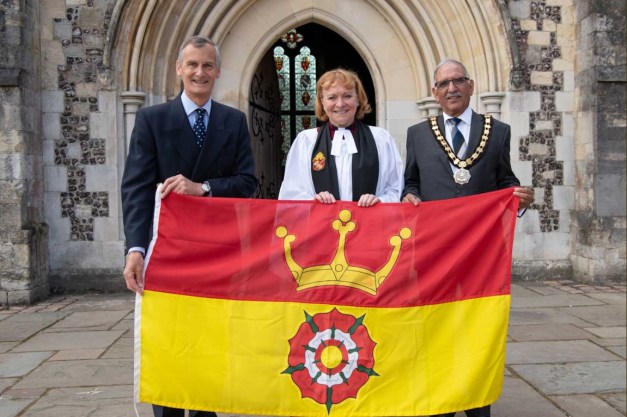
who blessed the flag
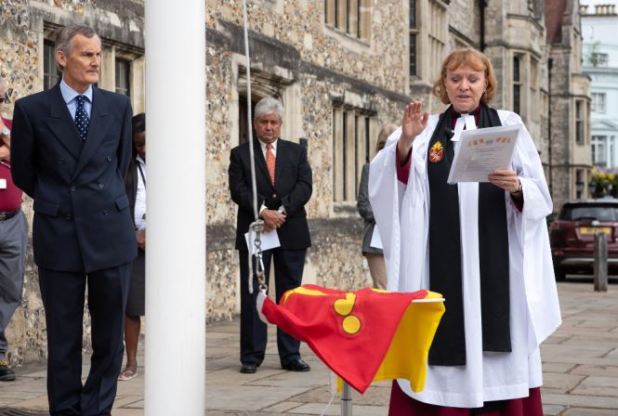
before it was raised by Nigel Atkinson
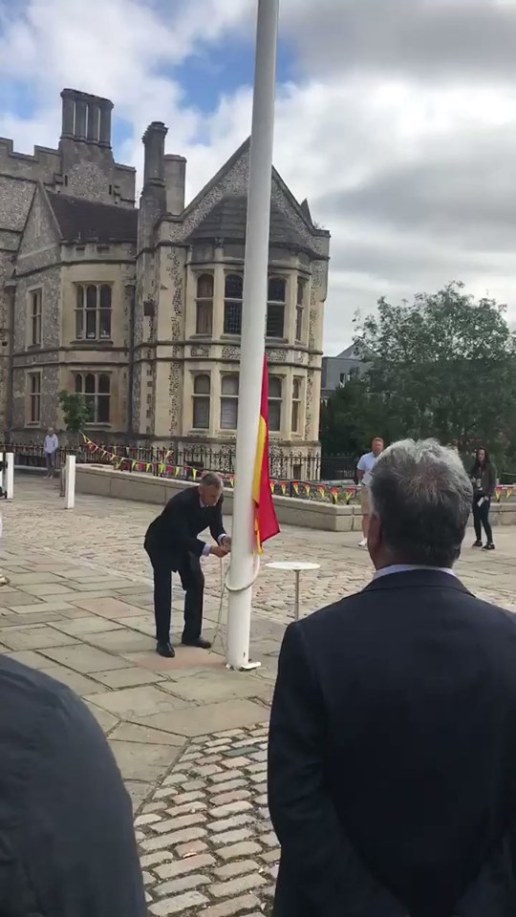

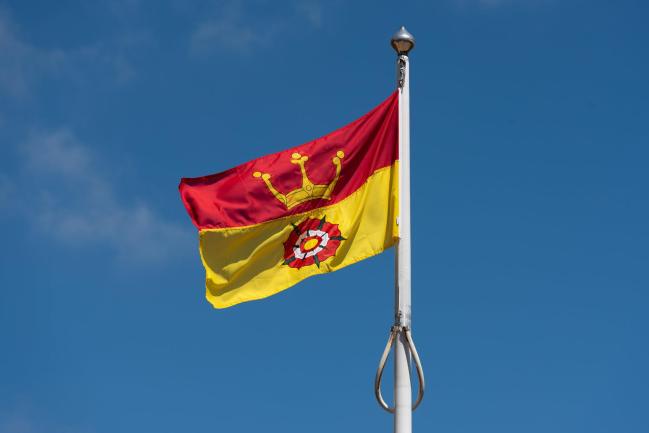
The county’s MPs joined in the celebrations
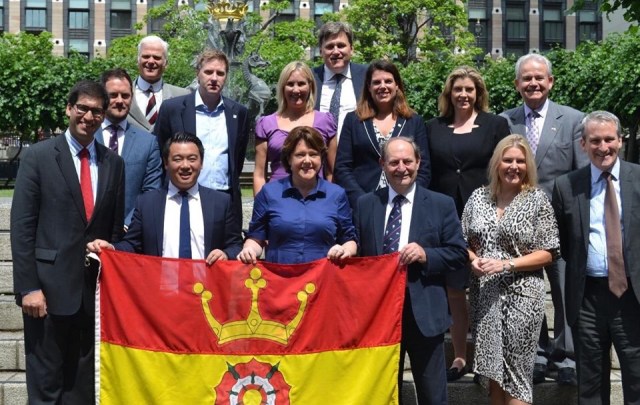
The flag was also raised in Southampton by the town’s mayor
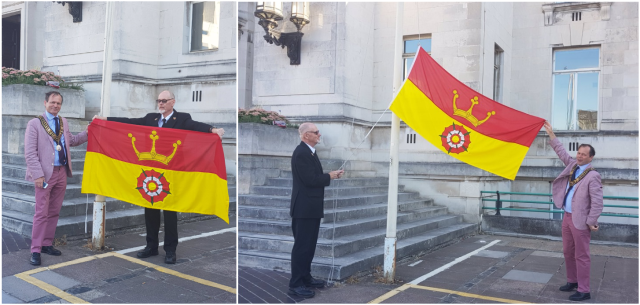

and made an appearance in Basingstoke
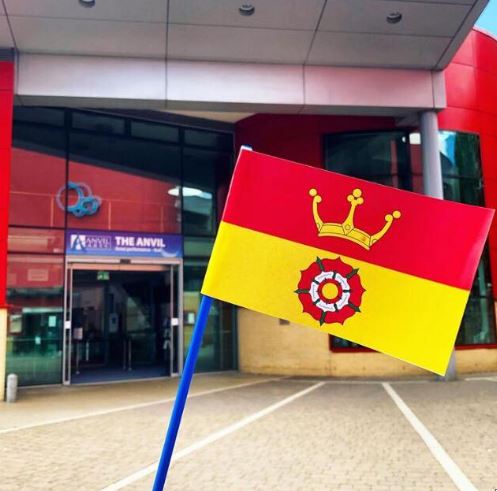
Sarisbury Green
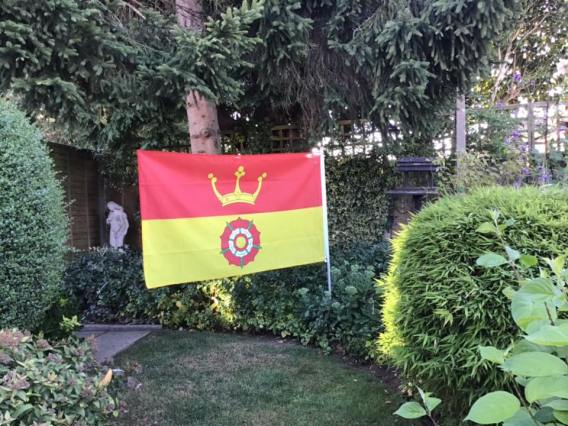
and one flag flew in Australia!

Eight days later, on July 23rd 2019, Historic County Flags Day #countyflagsday the Hampshire flag flew over Parliament Square, Westminster
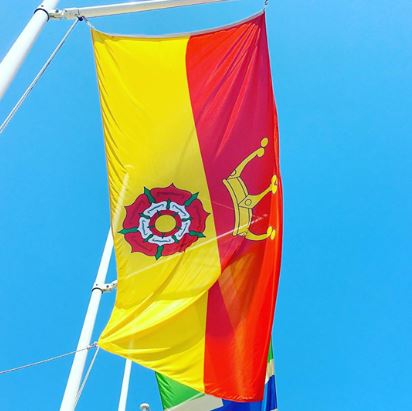
along with other county flags

are also the colours of the Wessex flag.

The kingdom of Wessex grew from its initial founding in the Hampshire area, along the coast and around Portsmouth and the status of Hampshire as the founding site of the kingdom of Wessex is reflected in the use of its colours, recalling the county’s important history and proud heritage.

Referencing the kingdom’s founding on the Hampshire coast and recognising that the shire system began in the kingdom of Wessex, a motto which describes Hampshire as “The first shire.” appears on this county sign

beneath the county flag. This description also recalls the fact that for a century or two, Hampshire was often the first shire, which many visitors to the UK encountered, when passenger bearing vessels frequently docked at Southampton, on the county’s coast.
Another flag used in the county,
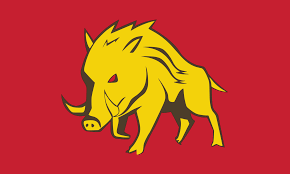
created by Mike Jacobs
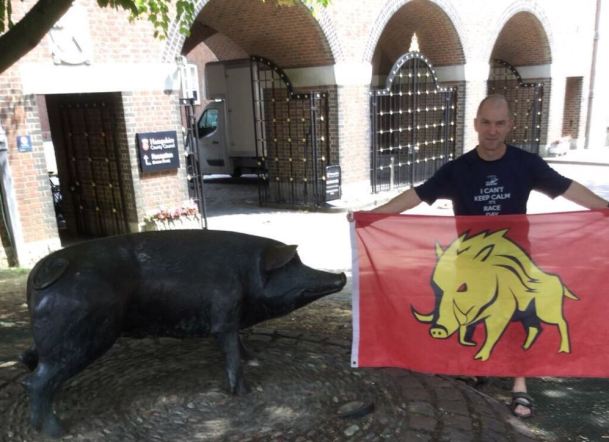
, which similarly uses the red and yellow Wessex colours, reflects Hampshire’s long held association with the “Hampshire Hog”

The county was the natural habitat of wild boar and became closely associated with the creature, with some of their number being domesticated and contributing to the “Hampshire Pig” and “Wessex Saddleback” breeds. Hampshire people consequently received the soubriquet “Hampshire Hogs” and it has become a popular county motif, depicted for example, in bronze,

outside the Winchester headquarters of Hampshire County Council, used as the name of a county pub
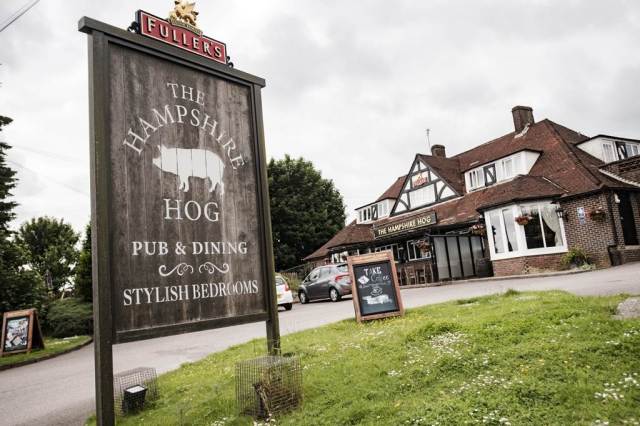
and featured on the labelling

of a company providing Hampshire produce.
The “Hampshire Hog” flag maintains this tradition and is a graphic characterisation of the county, similar in effect to the fighting kiwi

and boxing kangeroo
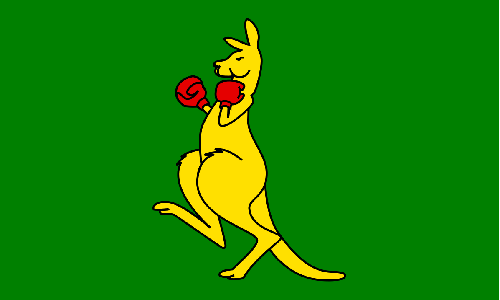
flags, used respectively by New Zealanders and Australians, to convey a proud national character, in conveying a proud local one!

The county flag

is promoted here.
